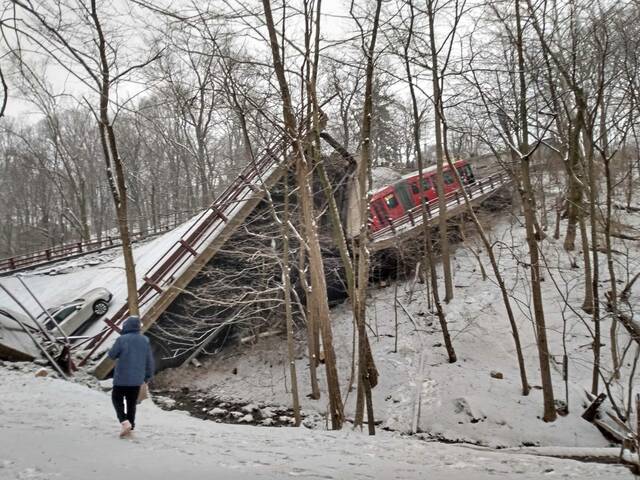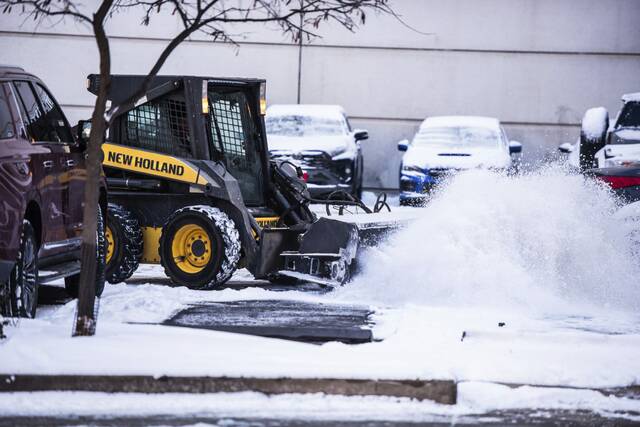PennDOT said $25.3 million in federal funding has been allocated to replace the collapsed Fern Hollow Bridge, and the state transportation agency will assist in design and construction.
Ten people were injured Friday when the bridge in Pittsburgh’s Frick Park collapsed, sending a Port Authority bus and several other vehicles into a ravine below.
“Our job now is to help the city get a bridge back as quick as we can,” said Cheryl Moon-Sirianni, district executive for PennDOT’s District 11, which includes Allegheny, Beaver and Lawrence counties.
The federal infrastructure bill provides the state with funding that can be used in various ways, Moon-Sirianni said. The Fern Hollow Bridge qualified for funding dedicated for national highway system bridges, she said.
“We’re going to try to be cost-effective,” she said, explaining that any money left over from the project could be put to use repairing or replacing other bridges.
Officials also are focusing on bridge designs that can be implemented quickly and that will match the aesthetics of the park, Moon-Sirianni said. The ultimate goal is to quickly construct a bridge that is “deemed to be the most effective and efficient.”
The collapsed Fern Hollow Bridge was one of six steel K-framed bridges — or bridges where the structure’s weight is placed on supports that don’t have a backup support — in Pennsylvania. The others are “all in much better condition,” Moon-Sirianni said.
Related
• Lower Burrell engineer, a whole week into his career, helps team lift 60-foot bus out of ravine• Crane pulls Port Authority bus from Frick Park bridge wreckage
• Complete coverage of the bridge collapse
PennDOT will inspect those similar bridges — including the ramp from Beechwood Boulevard to the Parkway East in Squirrel Hill, the Canon McMillan Alumni Bridge in North Strabane and the Shenango Road Bridge in Beaver — though they are all in fair or better condition and do not require posting for weight restrictions, said spokesman Steve Cowan.
PennDOT is assisting the city with the design and construction of the new bridge, though the bridge will be maintained by Pittsburgh once it is completed.
Moon-Sirianni said she “couldn’t even hazard a guess” on when the new bridge may completed. That will be determined by factors like bridge design and how quickly the necessary materials can be obtained, she said.
Had the bridge not collapsed, it was slated for repairs — or, ideally, replacement — within 12 years, she said.
As a team from the National Transportation Safety Board investigates the cause of the collapse, Moon-Sirianni said she stands by PennDOT’s inspection process. She said there are no plans to revamp its inspection system, though that could change depending on the results of the investigation.
“I will say that — right now — we do a very, very good job of inspecting our bridges, addressing needs when they come about,” she said. “I don’t think there’s anything we’re going to really change.”
She emphasized that PennDOT will shut down a bridge if inspectors feel it’s necessary.
The bridge was one of dozens in the region classified as being in poor condition. Those classifications are “based on the amount of deterioration on the structure,” said Shane Szalankiewicz, PennDOT District 11’s bridge engineer. Factors like missing concrete and rust on the steel can drop a bridge’s rating.
“A certain amount of deterioration is going to put you in that poor category,” he said. “Our inspectors are highly trained to be able to see if there’s something that alerts them.”
Bridges are typically inspected every two years, but bridges that are in poor condition may be inspected more frequently.
Fern Hollow Bridge was last inspected in September. PennDOT officials declined to provide the inspection report or any information regarding potential safety concerns regarding the bridge.
“Poor does not equate to unsafe,” Moon-Sirianni said, explaining that the term used to be “structurally deficient.” She said using the term poor condition “gives a really poor connotation to what the condition of the bridge is.”
Moon-Sirianni said bridges that people are using are generally safe, though Allegheny County has “one of the higher percentages” of bridges in poor condition across the state.
She said the reason for the high number of bridges in poor condition is “basically by virtue of the number of bridges that we have,” and the associated costs of taking care of so many major bridges.
The condition of the area’s bridges now are better than they once were, she said. At one point, more than 20% of the district’s bridges were in poor condition. Now, it’s around 8%.
She attributed the progress to increased funding to support bridges and other infrastructure needs, though she acknowledged there’s still a need for additional funding.








